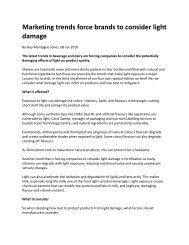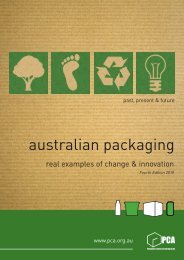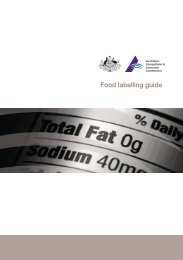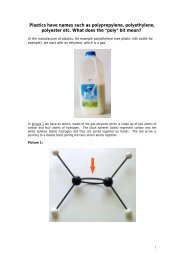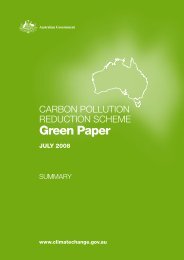Environmental Code of Practice for Packaging - the Packaging ...
Environmental Code of Practice for Packaging - the Packaging ...
Environmental Code of Practice for Packaging - the Packaging ...
You also want an ePaper? Increase the reach of your titles
YUMPU automatically turns print PDFs into web optimized ePapers that Google loves.
Existing and future relevant standards and legislation maintain <strong>the</strong>ir jurisdiction and status and shouldbe adhered to in conjunction with <strong>the</strong> <strong>Code</strong> and Guidelines.3.0 ObjectivesThe <strong>Code</strong> and Guidelines are intended to guide <strong>the</strong> packaging supply and recovery chains inminimising overall life cycle environmental impacts <strong>of</strong> packaging and packaged products, andachieving <strong>the</strong> overarching targets as set out in <strong>the</strong> Covenant. Accordingly, <strong>the</strong> objectives <strong>of</strong> <strong>the</strong> <strong>Code</strong>and Guidelines are to:1. Protect and deliver goods efficiently with <strong>the</strong> minimum environmental impact.2. Use resources (including materials and energy) more efficiently.3. Reduce <strong>the</strong> amount <strong>of</strong> waste and litter generated by packaging through facilitating reuse orrecycling.4. Minimise negative impacts <strong>of</strong> packaging and packaged products on humans and <strong>the</strong> naturalenvironment.5. Ensure effective and clearly documented practices are in place to address environmentalconcerns in <strong>the</strong> product development and review process <strong>for</strong> packaging and packaged products.More broadly, <strong>the</strong> <strong>Code</strong> and Guidelines should be seen as tools <strong>for</strong> <strong>the</strong> design and manufacture <strong>of</strong>innovative packaging that meets <strong>the</strong> sometimes conflicting demands <strong>of</strong> <strong>the</strong> market, consumer protectionand <strong>the</strong> environment.4.0 Definitions[It was agreed in <strong>the</strong> 23 March 2005 Task Force meeting that <strong>the</strong> definitions would have to be agreedon once <strong>the</strong> final Covenant package (including <strong>the</strong> NEPM) was completed and that definitions wouldneed to be consistent across both <strong>the</strong> <strong>Code</strong> and Covenant documents.]CEN” means <strong>the</strong> European Committee <strong>for</strong> Standardisation.“<strong>Code</strong>” means <strong>the</strong> <strong>Environmental</strong> <strong>Code</strong> <strong>of</strong> <strong>Practice</strong> <strong>for</strong> <strong>Packaging</strong>.“consumer packaging” means all packaging products made <strong>of</strong> any material, or combination <strong>of</strong>materials, <strong>for</strong> <strong>the</strong> containment, protection, marketing or handling <strong>of</strong> retail consumer products. This alsoincludes distribution packaging.“Covenant” means <strong>the</strong> National <strong>Packaging</strong> Covenant.“degradable” means a characteristic <strong>of</strong> a product or packaging that, with respect to specific conditions,allows it to break down to a specific extent within a given time.“distribution packaging” means packaging that contains multiples <strong>of</strong> products (<strong>the</strong> same or mixed)intended <strong>for</strong> consumer use, including:Secondary: packaging used to secure or unitise multiples <strong>of</strong> consumer packaging, eg. cardboard box,shipper, shrinkfilm overwrap.Tertiary: packaging used to secure or unitise multiples <strong>of</strong> secondary packaging, e.g. pallet wrappingstretchfilm, shrinkfilm, strapping.FINAL DOCUMENT 25 MAY 2005 - 2 -




